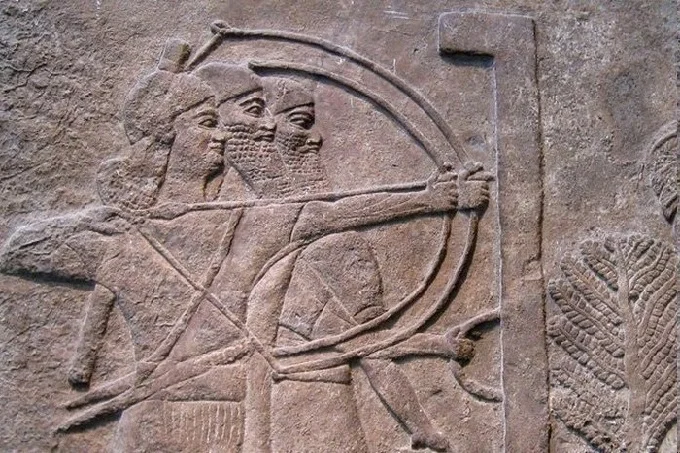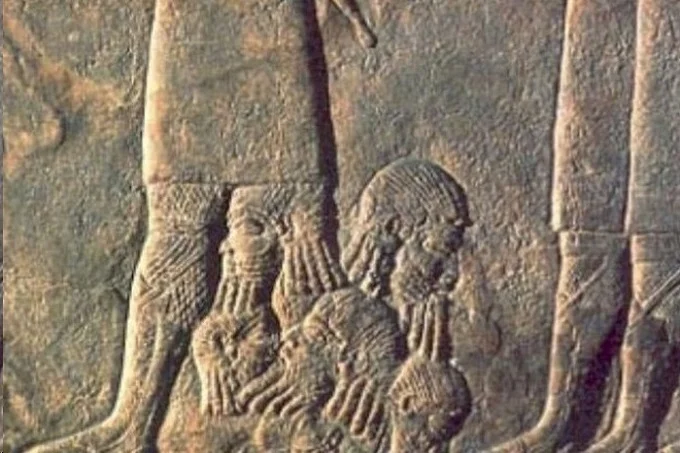Facts about the Assyrian army that terrified half of the world

About 3,000 years ago, a nation that few people remember today passed through the Middle East with a crushing tread. This army leveled cities to the ground, tortured survivors, and spread fear throughout the world. We are talking about Assyria – the first country that made military power the basis of its policy and the first country that terrorized its enemies through psychological warfare.
The terror of the army was employed to keep the newly conquered populace in order after they had been defeated. They constructed fortifications and highways across the empire in order to enable the army to move rapidly to problematic areas when necessary. Any attempt at revolt was immediately put down. Eventually, the Assyrian Empire grew to be much too large to handle in this manner anymore.
Facts about the Assyrian army that terrifying
Eternal war
From the poorest to the richest, every Assyrian man was obliged to serve in the army. It was the first country where military service was made mandatory for every male citizen, regardless of who he was. All men lived by the principle of “3 years”. In the first year, they built roads, bridges, and buildings to build up the power of the empire. In the second year, they went to war. And only in the third year, were they allowed to live with their families. As a result, Assyria had one of the strongest armies in the world. Moreover, they were well-trained and in constant battles warriors… and there were a lot of them.
Psychological terror
The Assyrians created tablets on which they painted and described the process of torturing their enemies so that the next city would know what would happen to its defenders. These plaques showed the process of skinning living people, gouging out their eyes, and putting them on stakes. After one of the Assyrian kings, Ashurnatsirapala II, a number of similar tablets remained, on which his atrocities during the seizure of cities were described: “I tore the skin off all the defenders of the city and hung it on the walls… I burned all the children… a tower was built out of the heads of the inhabitants in front of the city.” By the time the Assyrian army approached the walls of another city, its inhabitants already knew what was waiting for them.
A chance to give up
Before the battle began, people were often given a chance to surrender. A parliamentarian was sent to the city wall, who promised the defenders of the city (who were already shaking in fear, because they knew what was waiting for them) that if they surrendered and paid tribute to Assyria, they would be allowed to live: “Humble yourself and come out to me! Then each of you will eat your own grapes and fig tree fruits and drink water from your pond. And those who don’t come out will have to eat their own excrement and drink their own urine.” Many countries surrendered and paid tribute to Assyria, whose troops marched on.
Siege weapons
At that time, there were practically no siege guns. At best, the army could hope to break through the gates of the city, trying to knock them out with a log, often while archers were shooting at them from the walls. The Assyrians, however, invented some of the first siege weapons in the world. For example, they invented a battering ram – a device that seemed impossible to stop at the time. It was a complex structure on wheels, inside of which there was a huge log with an iron tip in the form of a ram’s head, which swung on chains, allowing you to break through enemy walls. The people inside the structure, who were swinging the log, were protected by wooden boards covered with raw animal skins, in which the burning arrows of the defenders of the city stuck and died.
Total destruction of cities
Sometimes, the Assyrian army did not stop at killing its enemies. When the Assyrian king Sennacherib invaded Babylon, he wiped it off the face of the earth. All that was left behind him was a boastful statement: “The city and its houses, from the base to the roofs, I plundered, destroyed and burned with fire… in the middle of the city I dug canals and flooded it with water. There is only a swamp left in place of Babylon.”
Torture of survivors

According to the surviving records, an Assyrian king spared some of the people of the captured cities: “the nobles and elders of the city came to me to save their lives… they fell at my feet and begged for mercy, asking me to do anything with them, just not to kill them.” Most often, these survivors were used to intimidate others, and in a rather cruel way – their noses and ears were cut off. And one of the kings, Asarhaddon, forced the nobility of the city he captured to wear “necklaces” with the severed heads of their rulers.
The life of slaves

The Assyrian wall paintings preserved images of slaves chained to large stones, which they were forced to drag like mules. These stones were used to create palaces and other architectural wonders for the kings, and the slaves who dragged them to the construction site could not even take a break (overseers were behind them, who beat anyone who “skipped”). Women who were taken into slavery were often treated even worse. Often they were stripped naked to humiliate and make them feel defenseless.
Resettlement policy
In Assyria, there was a policy of permanent resettlement of people – entire families were driven out of their homes and resettled all over the country. This was one of the reasons that made Assyria so powerful. Craftsmen from conquered countries were relocated to the heart of the empire, where they were sent to build palaces, temples, and wonders. They were often allowed to bring their families with them. Dangerous enemies who fought against Assyria were sometimes given a chance to redeem themselves. If the king was merciful, he sent them to rebuild the destroyed conquered country.
Code of Laws
Many crimes in Assyria were punished by self-mutilation or death. If someone kissed another person’s wife, his lower lip was cut off with an axe. If a man was “caught” with another man, he was turned into a eunuch. Adultery was punishable by death. Men had the right to kill wives who were caught in adultery. The killers were handed over to the victim’s family, who were free to do with them as they wished.
Post-traumatic stress
Life in Assyria was terrifying not only for the potential victims of the Assyrians but also for themselves. The soldiers of the Assyrian army had symptoms of what modern psychologists call post-traumatic stress. They heard and saw the ghosts of people who died in battle, and also talked to them. Scientists believe that the warriors experienced horror and guilt for killing and torturing innocent people.




